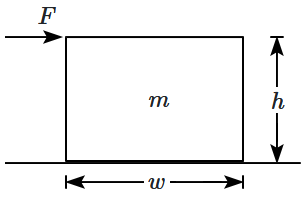A body of mass \(m\) is slipping on a rough horizontal plane, decelerating at \(6\) m/s2. The net force exerted by the plane on the body is: (take \(g =10~\text{m/s}^{2}\))
1. \(1.6~mg\)
2. \(0.4~mg\)
3. \(\sqrt{1.36}~mg\)
4. \(\sqrt{1.16}~mg\)

To unlock all the explanations of this course, you need to be enrolled.

To unlock all the explanations of this course, you need to be enrolled.

| Column-I | Column-II | ||
| \(\mathrm{(A)}\) | \(F_{\text{ext}}=mg,\mu=0\) | \(\mathrm{(I)}\) | \(a=g\sqrt2,N=\dfrac{5mg}{\sqrt2}\) |
| \(\mathrm{(B)}\) | \(F_{\text{ext}}=mg,\mu=\dfrac12\) | \(\mathrm{(II)}\) | \(a=\dfrac{3g}{\sqrt2},N=\dfrac{5mg}{\sqrt2}\) |
| \(\mathrm{(C)}\) | \(F_{\text{ext}}=4mg,\mu=0\) | \(\mathrm{(III)}\) | \(a=\dfrac{g}{\sqrt2},N=\sqrt2mg\) |
| \(\mathrm{(D)}\) | \(F_{\text{ext}}=4mg,\mu=\dfrac15\) | \(\mathrm{(IV)}\) | \(a=0,N=\sqrt2mg\) |
| 1. | \(\mathrm{A\text-IV,B\text-III,C\text-I,D\text-II}\) |
| 2. | \(\mathrm{A\text-IV,B\text-IV,C\text-II,D\text-I}\) |
| 3. | \(\mathrm{A\text-III,B\text-IV,C\text-II,D\text-I}\) |
| 4. | \(\mathrm{A\text-III,B\text-III,C\text-I,D\text-II}\) |

To unlock all the explanations of this course, you need to be enrolled.

To unlock all the explanations of this course, you need to be enrolled.

| 1. | \(\dfrac{3}{4} \times 30 ~\text{N}\) | 2. | \(\dfrac{4}{3} \times 30 ~\text{N}\) |
| 3. | \(\dfrac{3}{5} \times 30 ~\text{N}\) | 4. | \(\dfrac{4}{5} \times 30~\text{N}\) |

To unlock all the explanations of this course, you need to be enrolled.

To unlock all the explanations of this course, you need to be enrolled.

Consider the following situations:
| (P) | \(f_A,~f_B>0\) | (Q) | \(f_A,~f_B<0\) |
| (R) | \(f_A>0,~ f_B<0\) | (S) | \(f_A<0,~ f_B>0\) |
Which of the above, are possible? Assume that the string is taut.
1. (P) or (Q)
2. (R) or (S)
3. Any of (P), (Q), (R), (S)
4. Only (P)

To unlock all the explanations of this course, you need to be enrolled.

To unlock all the explanations of this course, you need to be enrolled.

Consider the statements:
| (P) | \(f\) increases if \(m\) is increased. |
| (Q) | \(f\) increases if \(F_A\) is increased. |
| (R) | \(f\) increases if \(F_R\) is increased. |
2. Only Q is True.
3. P, Q are True.
4. Only R is True.

To unlock all the explanations of this course, you need to be enrolled.

To unlock all the explanations of this course, you need to be enrolled.

| 1. | \(N\) increases as \(F\) increases. |
| 2. | \(N\) does not act through the center of the block. |
| 3. | \(f\) is greater than \(F.\) |
| 4. | \(f\) acts through the centre of the block. |

To unlock all the explanations of this course, you need to be enrolled.

To unlock all the explanations of this course, you need to be enrolled.

1. \(8\) N
2. \(6\) N
3. \(4\) N
4. \(2\) N

To unlock all the explanations of this course, you need to be enrolled.

To unlock all the explanations of this course, you need to be enrolled.

1. \(10\) N
2. \(10 \sqrt 2\) N
3. \(5 \sqrt 2\) N
4. \(5\) N

To unlock all the explanations of this course, you need to be enrolled.

To unlock all the explanations of this course, you need to be enrolled.

1. \(\mu_s=0.4\)
2. \(\mu_s=\mu{\small_k}=0.4\)
3. \(\mu{\small_ k}=0.4\)
4. \(\mu_s\geq0.4\)

To unlock all the explanations of this course, you need to be enrolled.

To unlock all the explanations of this course, you need to be enrolled.
1. \(S_A=2S_B\)
2. \(S_B=2S_A\)
3. \(4S_A=S_B\)
4. \(S_A=S_B\)

To unlock all the explanations of this course, you need to be enrolled.

To unlock all the explanations of this course, you need to be enrolled.






